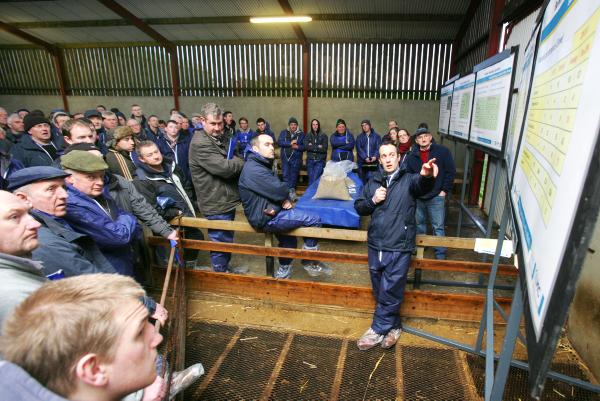More than 200 farmers attended the first in a series of sheep farm walks organised by AgriSearch on Tuesday of this week.
Host farmer Isaac Crilly is well known to sheep producers across Northern Ireland, having held numerous visits and farm walks through the Focus Farm programme.
Farm system
As access to land is restricting farm expansion, Isaac is focused on maximising output by producing easy-care, maternal ewes capable of increasing lamb numbers annually.
There is less focus on carcase traits, given that a U grade lamb is worth £2 extra, compared to an additional 0.1 lambs weaned per ewe, which is worth approximately £8 at today’s prices. Around 25% of lambs are sold before weaning, with the remaining 75% sold by October.
Isaac benchmarks the farm annually. In 2013, lamb sales averaged 1.58 lambs/ewe (including ewe lambs) with a 19kg carcase averaging £119/head. Concentrates fed averaged 209kg/ewe, an increase of 38kg/ewe as a result of the fodder crisis last spring.
This meant variable costs increased by £19/ewe, leaving a gross margin (GM) of £29/ewe, which is £20/ewe less than the average benchmarked farm. Despite the lower GM/ewe, the GM/ha was £548 in 2013, which is £170/ha more than the average, due to the high stocking rate.
Research
The farm has been working with the Agri-food and Biosciences Institute (AFBI) for 15 years and has been heavily involved with breeding programmes aimed at producing crossbred sheep to suit NI farms. Isaac is mainly focussed on maternal traits.
A New Zealand Suffolk ram was imported for crossing with Belclare ewes to improve lamb growth rates. Lambing ease, prolificacy, worm burdens and feet problems are all recorded through AFBI and this information is used to select replacements.
Replacements are bred to the New Zealand Suffolk and a crossbred New Zealand Suffolk X Texel. The introduction of New Zealand genetics has reduced worm burdens in the flock.
Ewes not suited to breeding are crossed with a Meatlinc ram – a five-breed terminal composite. Isaac stated that he only wants naturally reared sheep and will not buy rams that are overfed on meals.
Working with AFBI to breed easier-care sheep has seen lambing interventions reduce from 40% to just under 5%.
Nutrition
As Isaac operates a sheep-only system, he does not make silage. Instead, he prefers to use all of his land for carrying ewes. Ewes are housed in mid-December and fed soya hulls and wheat straw. Body condition score must be at least 3.5, reducing down to 3.0 at lambing in March.
Soya bean is introduced gradually and increased closer to lambing. Ewes are fed 1kg/head/day of ration with feed costs running from £0.19/day after housing to £0.32/day closer to lambing. Mineral supplementation is crucial in Isaac’s system. Blood samples have shown that ewes are deficient in selenium at grass, so a drench is provided.
The advice given to producers at the farm walk who are feeding silage is to get it analysed. There is no point feeding concentrates based on a guess. Ewes offered poor silage (56 D-Value) need 33% more silage to supply the same amount of energy as good silage (67 D-Value). Over a six-week period, the good silage requires supplementing with 12kg/ewe of concentrates to meet a twin-bearing ewe’s nutritional demand, while on the poor silage, 28kg/ewe is required.






 This is a subscriber-only article
This is a subscriber-only article







SHARING OPTIONS: